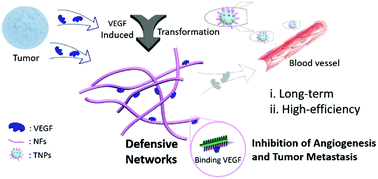In situ construction of nanonetworks from transformable nanoparticles for anti-angiogenic therapy†
Abstract
Tumor metastasis as the most common reason of death from cancer has always been a great challenge in both clinical and scientific research, where angiogenesis plays a necessary role. Herein, we report an extracellularly transformable nanomaterial for in situ construction of defensive networks on interaction with vascular endothelial growth factor (VEGF) for anti-angiogenic therapy of tumor. The fibrous networks exhibit transformation-enhanced accumulation and retention (TEAR) effects (over 72 h), and bind and intercept cell-secreted VEGF over particulate and molecular anti-angiogenic agents with high efficiency, leading to anti-angiogenesis. This study demonstrates that angiogenesis is positively related to tumor growth as well as tumor metastasis; the anti-angiogenic therapy inhibits tumor metastasis with an inhibition rate of 65.9%. In addition, this extracellular strategy of transformation may be utilized to bind huge amounts of cell-secreted biomolecules/factors or receptors on cell surfaces and inhibit their functionalities for cancer therapy.



 Please wait while we load your content...
Please wait while we load your content...